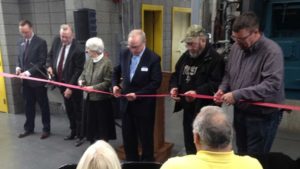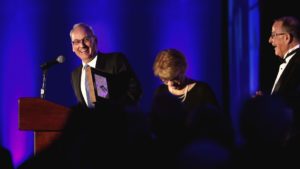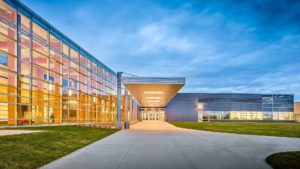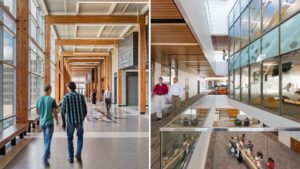Surrounded by rich farmland, Grand Forks sits in the Red River Valley and is at the confluence of the Red and Red Lake Rivers. The Red River winds all the way up from Breckenridge, Minnesota to Winnipeg, Manitoba in Canada and the Red Lake River winds its way from Minnesota and combines with the Red River at Grand Forks. While these rivers are popular with locals for canoeing and other recreational activities, they can be also devastating. The most tremendous effects were felt during the flood of ’97, when most of the entire population of more than 50,000 people had to be evacuated. There was a very significant snowfall that year and when the ice melted in April, this contributed to the rise in the water level which peaked at 54 feet. It would be over a month before the water receded and people could return to what was left of their homes. This spurred the city’s governors to take action. Todd Feland, Grand Forks City Administrator, is currently overseeing the Grand Forks Water Treatment Project; a significant, brand new infrastructure that will provide clean water to its citizens.
The once in a lifetime project
Feland explains that this project had already been in the planning before the flood happened, but it did change the paradigm of where the facility needed to be located. Rather than build it in the more constrained downtown area near the river, a decision was made to build it on the west side of the town, along with the reservoir and pump station, where there is also more space to expand. “[The flood] allowed the City of Grand Forks to reinvent its protection systems.” Feland says. “It was really out of a bad situation that, working with our federal and state partners we were able to come up with a better system that provided much more security in our community. “Instead of having the river be your enemy we were able to move back and create recreational opportunities. We like to think we’re a little bit of a poster child for flood recovery.” The old facility will be converted into a mixed-use development, which Feland believes will be a great project. “That will be exciting for the community to see how we can redevelop areas that have been more of an industrial setting,” he added. “We’re not London, England, but even in Grand Forks people are focused on downtown redevelopment. The water treatment plant site will be more of a mixed use setting as opposed to having a water treatment plant which is more of an industrial setting. It’s really a unique way we can redevelop. The flood was the trigger to move this forward.”
Bringing new technology to Grand Forks
The state of the art facility is expected to treat up to 20 million gallons of water each day once it’s completed. Innovative technology is being developed to handle problems like pesticides and herbicides from the surrounding sugar beet, wheat and corn fields as well as discharges from the nearby Devil’s Lake and wastewater discharges from downstream municipal and industrial point sources. For this they’re using a GE membrane system to treat the source water. Additionally, ozone treatment processes will ensure it’s sustainable. “It can treat water at different times of the year, whether it’s in the summer when things are dryer, or in the winter when it’s colder water. We needed to create it in a challenging climactic condition and challenging river source water that could be really adaptable. During different times of the year based on what’s occurring we can decide how to treat the water the most cost-effective way, and still assuring our citizens and industries that our source water is of the highest value.” “We need the plant to be really adaptive,” Feland says. “We looked at how we’re going to treat source water that’s challenging to begin with, and how we could build a plant that had to be a fiftyyear plant on a hundred-year site.” The project will cost approximately $150m, which will partly be funded by the state of North Dakota who are paying 50 percent of it, along with rate increases and possible sales tax and the ‘Drinking Water State Revolving Loan Fund’, a long-term loan with a low interest rate with terms of 2 percent for 30 years.
Inspiration
Before starting construction, Feland and his team carried out bench-testing with various types of technology and also took field trips to look at what systems other facilities employed. One was in the suburbs of Denver, Colorado, where they also use membrane technology; however, the source water there, coming from the mountains, is cleaner. They also looked at the central Minneapolis area and Fargo, which is 80 miles south of Grand Forks, and where they also use a membrane facility. “That plant is further into construction than we are,” Feland explains. “We can draw a lot of inference from them because they’re treating similar water as we are.”
Contracting challenges
The greatest challenge is getting this ultra-modern project completed on time. To ensure a seamless transition, Feland cites Melanie Parvey, Director of Water, for bringing in the operations and design teams very early on in the process. This way when they move in to the new, more sophisticated plant the team will already have their fingerprints on all the operations. Construction began in December 2016 and it’s expected to be fully operational in the summer of 2020, which is a very short timeline for such a significant construction project. This was not without its challenges. Just as the final design and construction stages were about to begin, there was an oil boom in North Dakota, which meant most of the qualified contractors were engaged. This posed a problem in terms of getting reasonable bids. Under state statutes companies are allowed to hire construction managers at risk, so they completed an RFP (Request for Proposal) and partnered with a local/national construction management team called Construction Engineer-Ulliman Schuette, a Joint Venture. This company became involved with almost half of the final design to ensure it was effective as possible. The benefits of this project for the community’s wellbeing will be terrific. Feland says: “It’s going to set the city up for the next 50 to 100 years in our distribution and treatment system. As the city grows it will be able to transmit this water in a reasonable way. What we’ve done here, for further generations it will become more and more valuable.”



